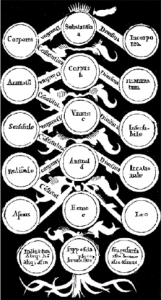L'arbre de la prophétie, d'après la traduction de Boèce de l'"Isagoge"
Résumé
This study advocates the need for an aestethic grounding for the figural syntax of poetry. To this end, it argues that the vertical semiotic model - “logocentric” and grounded in common sense – must be replaced with a horizontal semiosis in which a key role is played by processes of dynamic image combination. First, the study explores the semiotic problem posed by figurality in poetry, and argues for an integration of consolidated models and methods. It then goes on to outline the foundations of an aesthetic grounding of figurality, drawing primarily on iconology and the semantics of fiction. Rudolf Arnheim's Gestaltpsychologie and W. J. T. Mitchell's theories are relied on in order to try to identify the key properties of the verbal image, both in everyday language use and in literary usage. Finally, on the basis of Sergej Ejzenštein's transmedial, inner conceptualization of montage, four different types of figural mechanisms are identified, i.e. detail selection, montage proper, camera positioning and image quality. The revised and updated toolkit for stylistic analysis resulting from this reconceptualization of the figural syntax of poetry is then tested on excerpts from a variety of authors and traditions, ranging from Horace, to John Donne to Andrea Zanzotto.

Téléchargements
Publiée
Comment citer
Numéro
Rubrique
Licence
(c) Tous droits réservés Elephant & Castle 2023

Ce travail est disponible sous la licence Creative Commons Attribution 4.0 International .





